In this article we are going to look at some options and examples of how you can use FFmpeg multimedia framework to perform various conversion procedures on audio and video files.
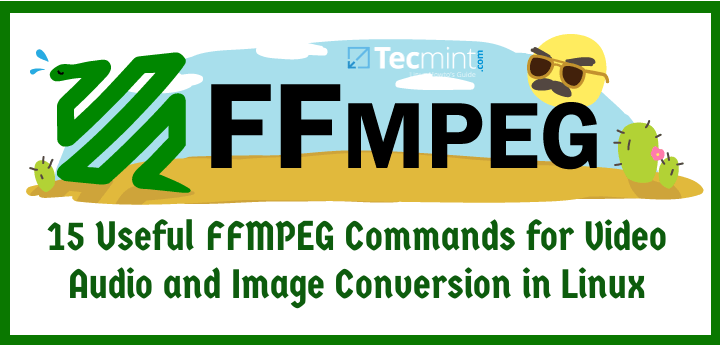
For more details about FFmpeg and steps to install it in different Linux distros, read the article from the link below:
FFmpeg Multimedia Framework Installation Guide on Linux – Part 1
Useful FFmpeg Commands
FFmpeg utility supports almost all major audio and video formats, if you want to check the ffmpeg supported available formats you can use ./ffmpeg -formats command to list all supported formats. If you are new to this tool, here are some handy commands that will give you a better idea about the capabilities of this powerful tool.
1. Get Video File Information
To get information about a file (say video.mp4), run the following command. Remember you have to specify an ouput file, but in this case we only want to get some information about the input file.
$ ffmpeg -i video.flv -hide_banner
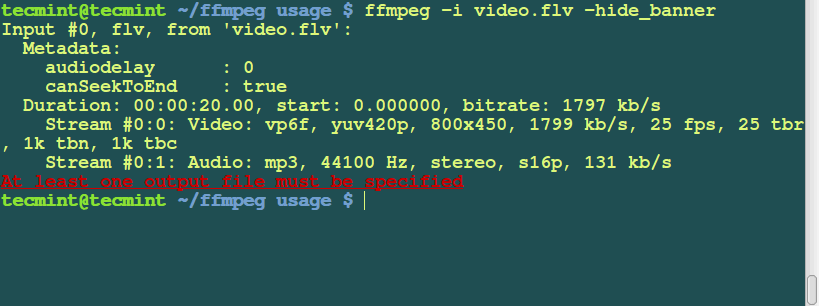
Note: The -hide_banner option is used to hide a copyright notice shown my ffmpeg, such as build options and library versions. This option can be used to suppress printing this information.
For example, if you run the above command without adding -hide_banner option it will print the all FFmpeg tools copyright information as shown.
$ ffmpeg -i video.flv
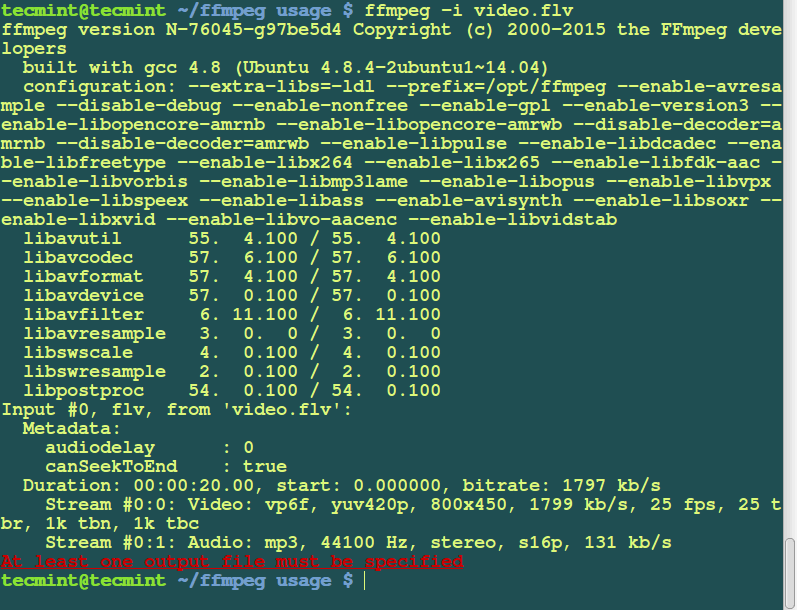
2. Split a video into images
To turn a video to number of images, run the command below. The command generates the files named image1.jpg, image2.jpg and so on…
$ ffmpeg -i video.flv image%d.jpg
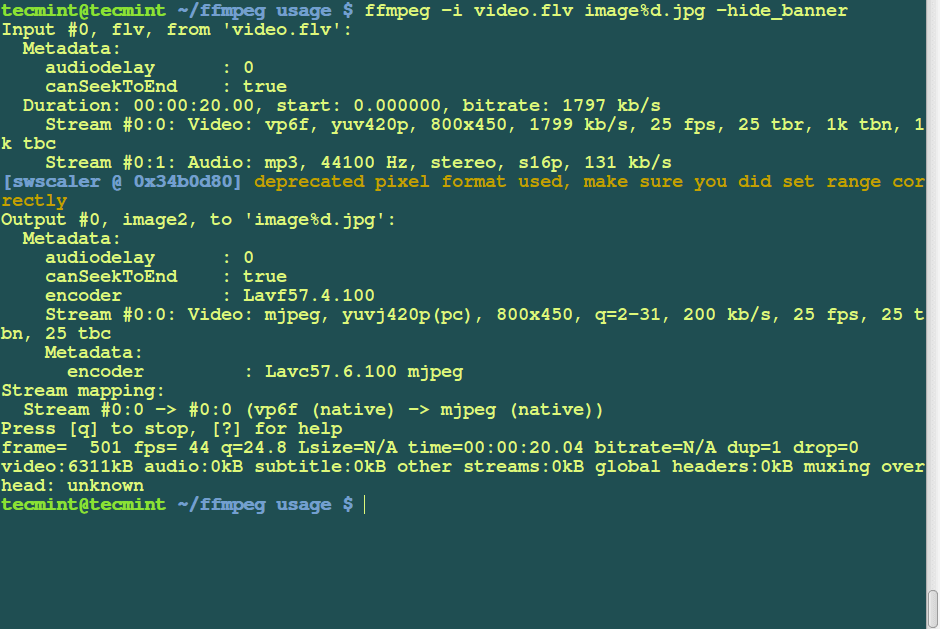
After successful execution of above command you can verify that the video turn into multiple images using following ls command.
$ ls -l total 11648 -rw-r--r-- 1 tecmint tecmint 14592 Oct 19 13:19 image100.jpg -rw-r--r-- 1 tecmint tecmint 14603 Oct 19 13:19 image101.jpg -rw-r--r-- 1 tecmint tecmint 14584 Oct 19 13:19 image102.jpg -rw-r--r-- 1 tecmint tecmint 14598 Oct 19 13:19 image103.jpg -rw-r--r-- 1 tecmint tecmint 14634 Oct 19 13:19 image104.jpg -rw-r--r-- 1 tecmint tecmint 14693 Oct 19 13:19 image105.jpg -rw-r--r-- 1 tecmint tecmint 14641 Oct 19 13:19 image106.jpg -rw-r--r-- 1 tecmint tecmint 14581 Oct 19 13:19 image107.jpg -rw-r--r-- 1 tecmint tecmint 14508 Oct 19 13:19 image108.jpg -rw-r--r-- 1 tecmint tecmint 14540 Oct 19 13:19 image109.jpg -rw-r--r-- 1 tecmint tecmint 12219 Oct 19 13:18 image10.jpg -rw-r--r-- 1 tecmint tecmint 14469 Oct 19 13:19 image110.jpg
3. Convert images into a video
Turn number of images to a video sequence, use the following command. This command will transform all the images from the current directory (named image1.jpg, image2.jpg, etc…) to a video file named imagestovideo.mpg.
There are many other image formats (such as jpeg, png, jpg, etc) you can use.
$ ffmpeg -f image2 -i image%d.jpg imagestovideo.mpg
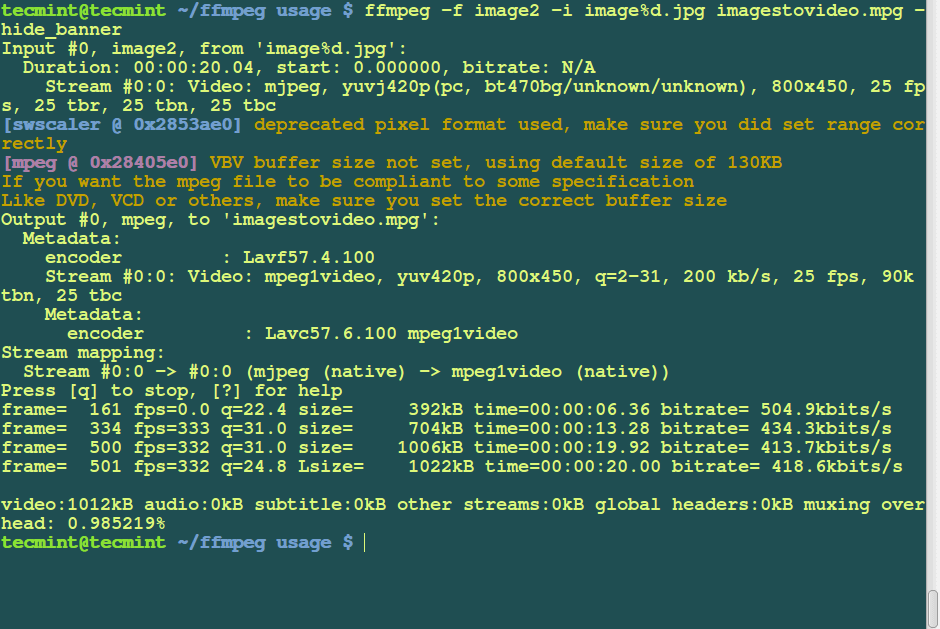
4. Convert a video into mp3 format
To convert an .flv format video file to Mp3 format, run the following command.
$ ffmpeg -i video.flv -vn -ar 44100 -ac 2 -ab 192 -f mp3 audio.mp3
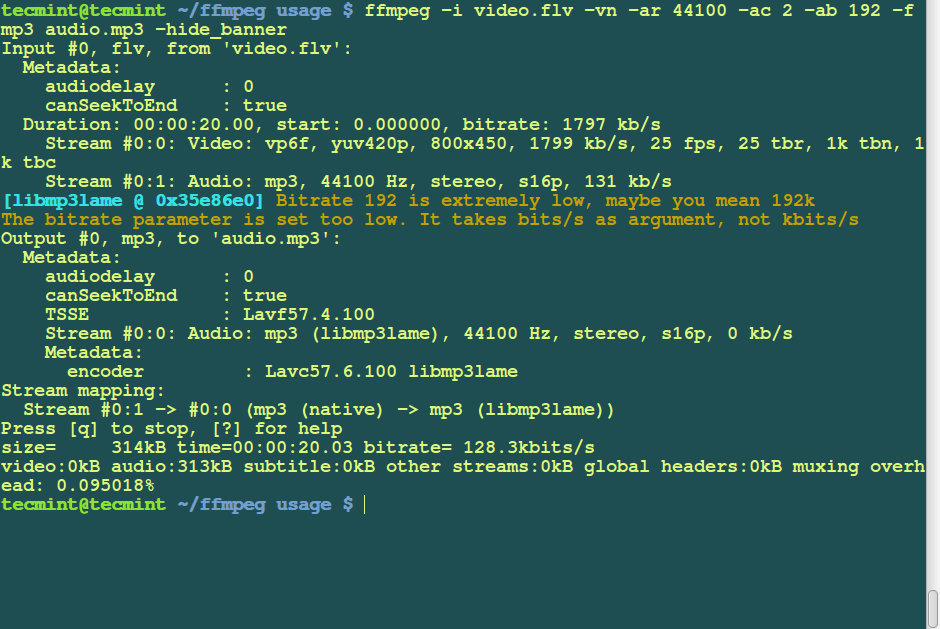
Description about the options used in above command:
- vn: helps to disable video recording during the conversion.
- ar: helps you set audio sampling rate in Hz.
- ab: set the audio bitrate.
- ac: to set the number of audio channels.
- -f: format.
5. Covert flv video file to mpg format
To convert a .flv video file to .mpg, use the following command.
$ ffmpeg -i video.flv video.mpg
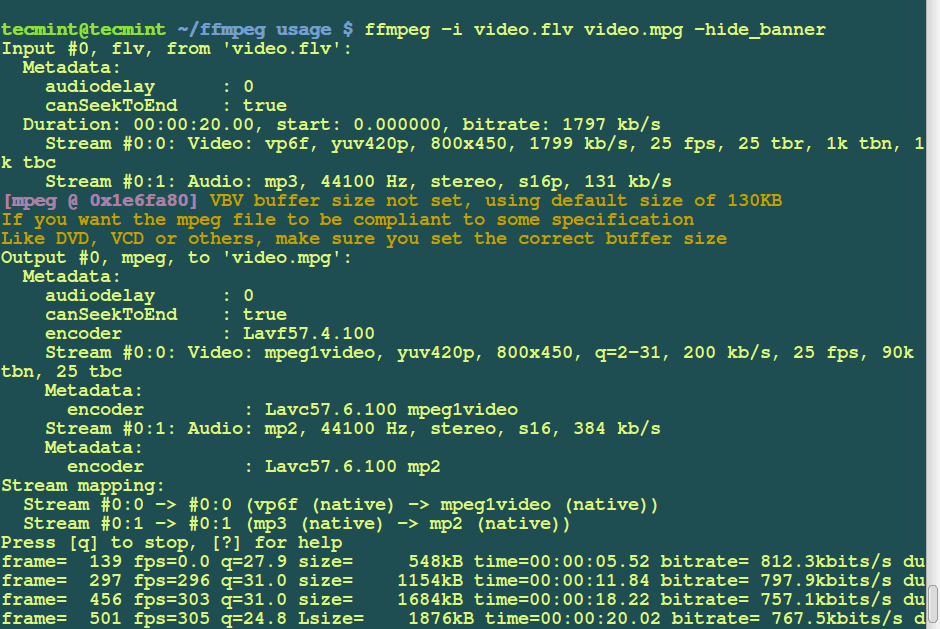
6. Convert video into animated gif
To convert a .flv video file to animated, uncompressed gif file, use the command below.
$ ffmpeg -i video.flv animated.gif.mp4
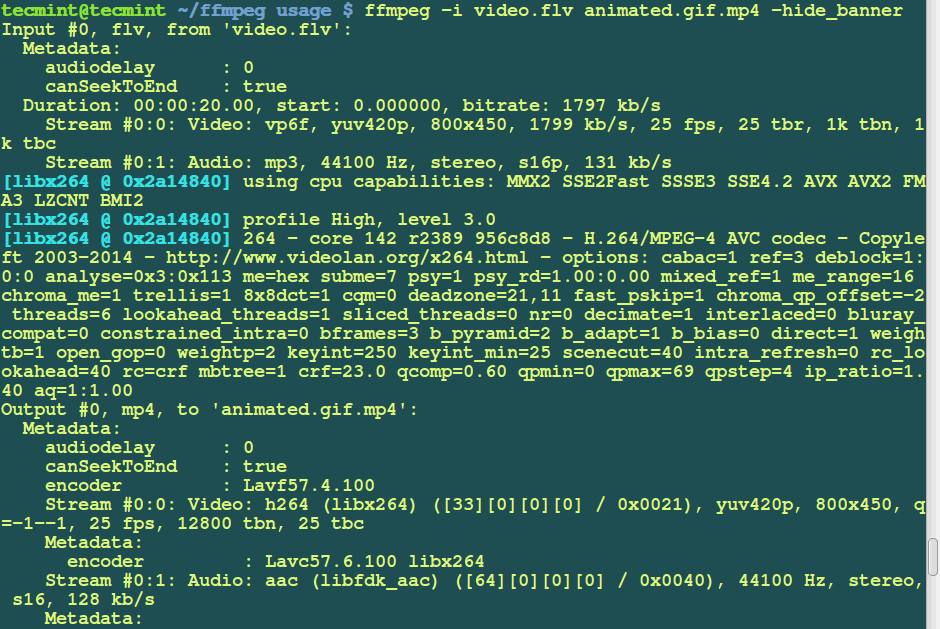
7. Convert mpg video file to flv
To convert a .mpg file to .flv format, use the following command.
$ ffmpeg -i video.mpg -ab 26k -f flv video1.flv
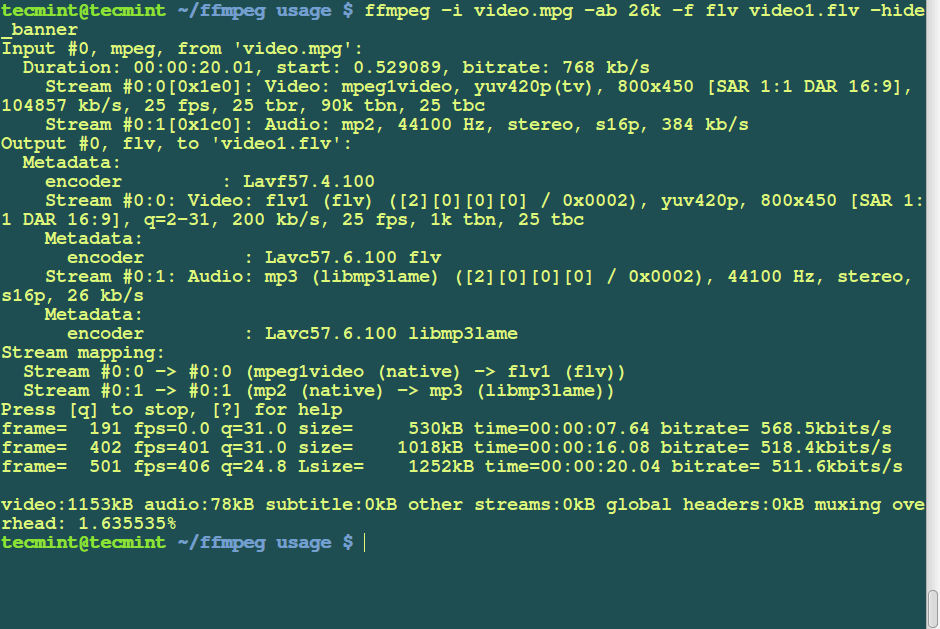
8. Convert avi video file to mpeg
To convert a .avi file to mpeg for dvd players, run the command below:
$ ffmpeg -i video.avi -target pal-dvd -ps 2000000000 -aspect 16:9 video.mpeg
Explanation about the options used in above command.
- target pal-dvd : Output format
- ps 2000000000 maximum size for the output file, in bits (here, 2 Gb).
- aspect 16:9 : Widescreen.
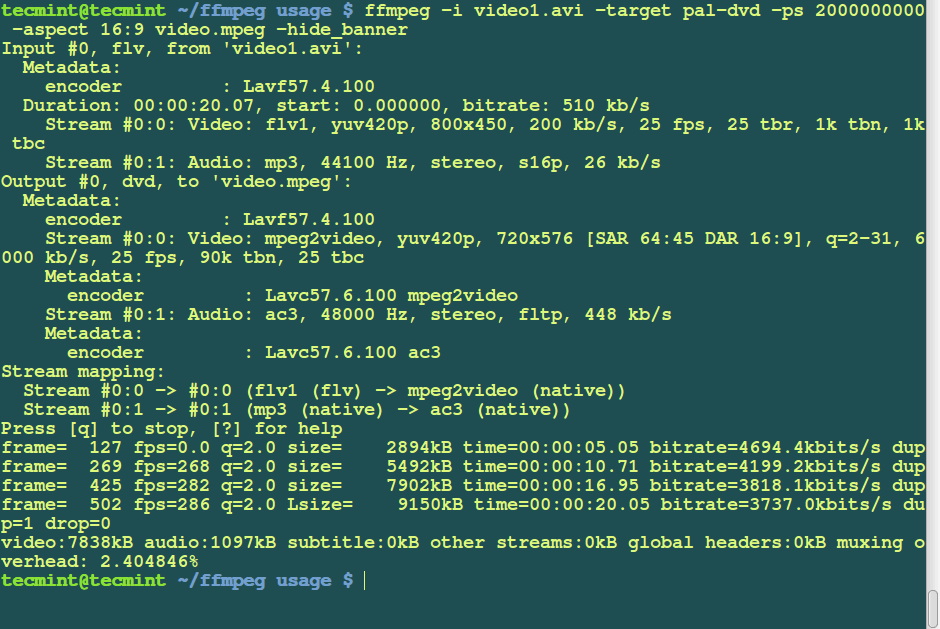
9. Convert a video to CD or DVD format
To create a video CD or DVD, FFmpeg makes it simple by letting you specify a target type and the format options required automatically.
You can set a target type as follows: add -target type; type can of the following be vcd, svcd, dvd, dv, pal-vcd or ntsc-svcd on the command line.
To create a VCD, you can run the following command:
$ ffmpeg -i video.mpg -target vcd vcd_video.mpg
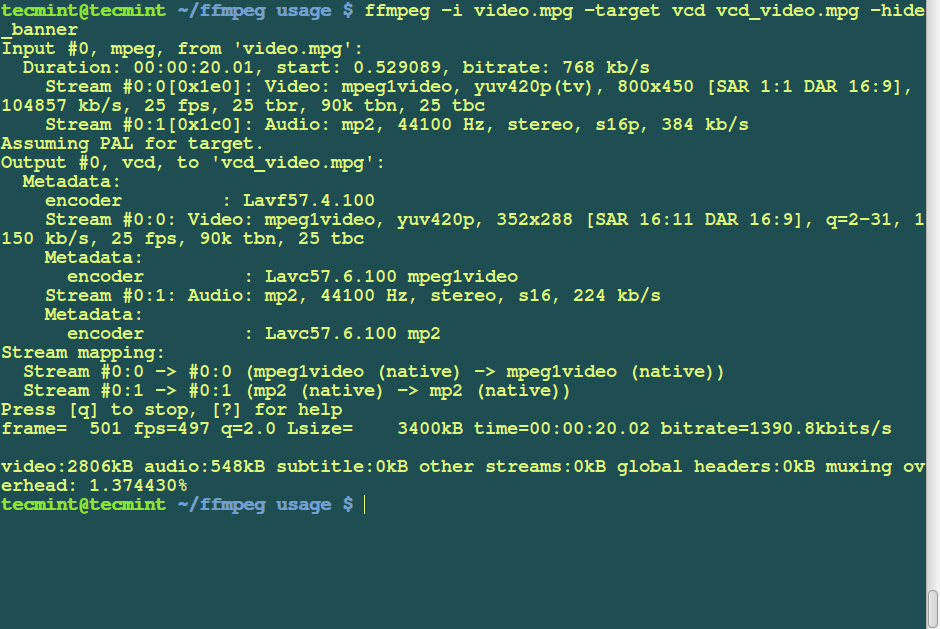
10. Extract audio from video file
To extract sound from a video file, and save it as Mp3 file, use the following command:
$ ffmpeg -i video1.avi -vn -ar 44100 -ac 2 -ab 192 -f mp3 audio3.mp3
Explanation about the options used in above command.
- Source video : video.avi
- Audio bitrate : 192kb/s
- output format : mp3
- Generated sound : audio3.mp3
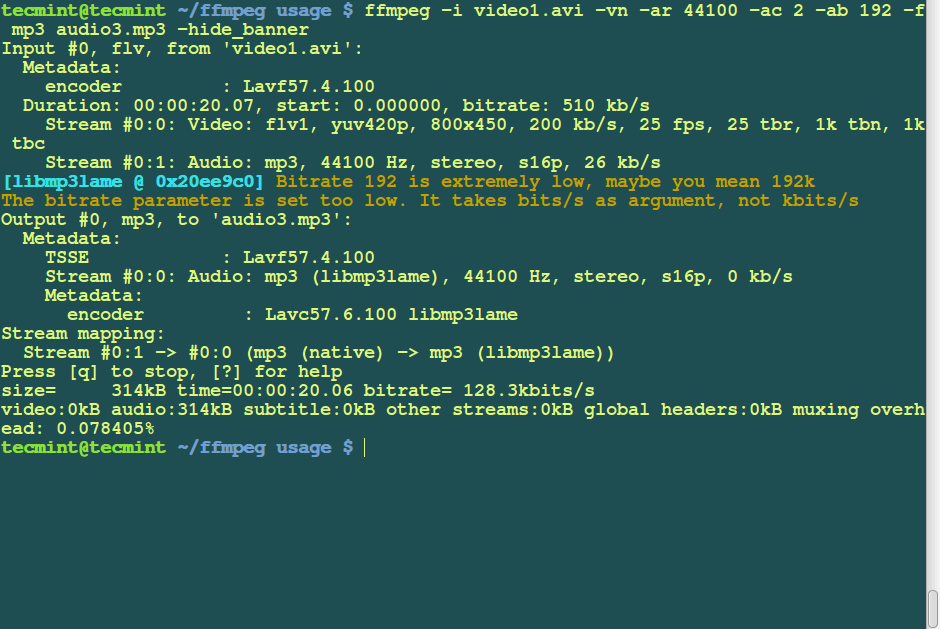
11. Mix a video and audio together
You can also mix a video with a sound file as follows:
$ ffmpeg -i audio.mp3 -i video.avi video_audio_mix.mpg
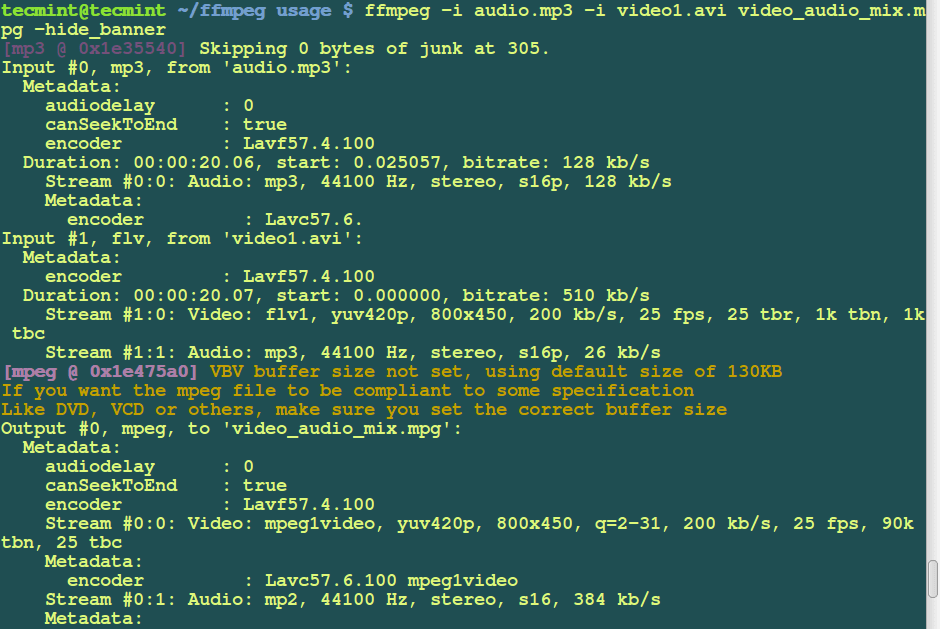
12. Increase/Reduce Video Playback Speed
To increase video play back speed, run this command. The -vf option sets the video filters that helps to adjust the speed.
$ ffmpeg -i video.mpg -vf "setpts=0.5*PTS" highspeed.mpg
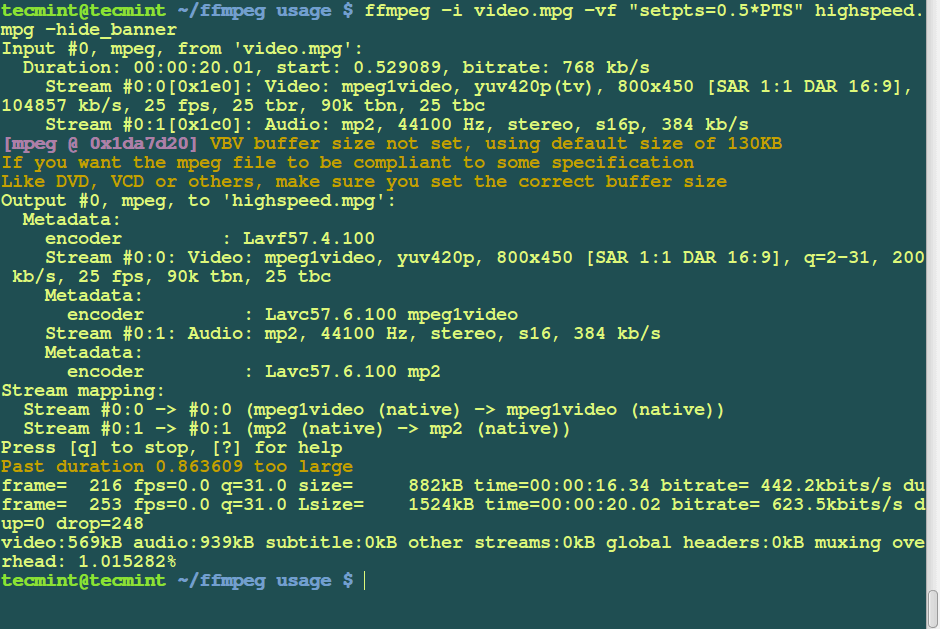
You can also reduce video speed as follows:
$ ffmpeg -i video.mpg -vf "setpts=4.0*PTS" lowerspeed.mpg -hide_banner
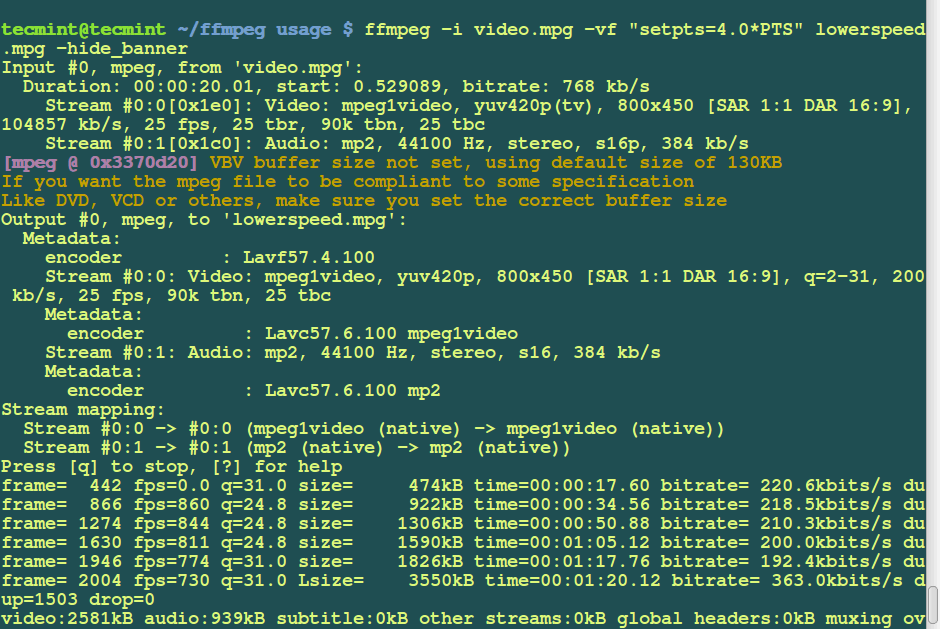
13. Compare/Test Video and Audio Quality
To compare videos and audios after converting you can use the commands below. This helps you to test videos and audio quality.
$ ffplay video1.mp4
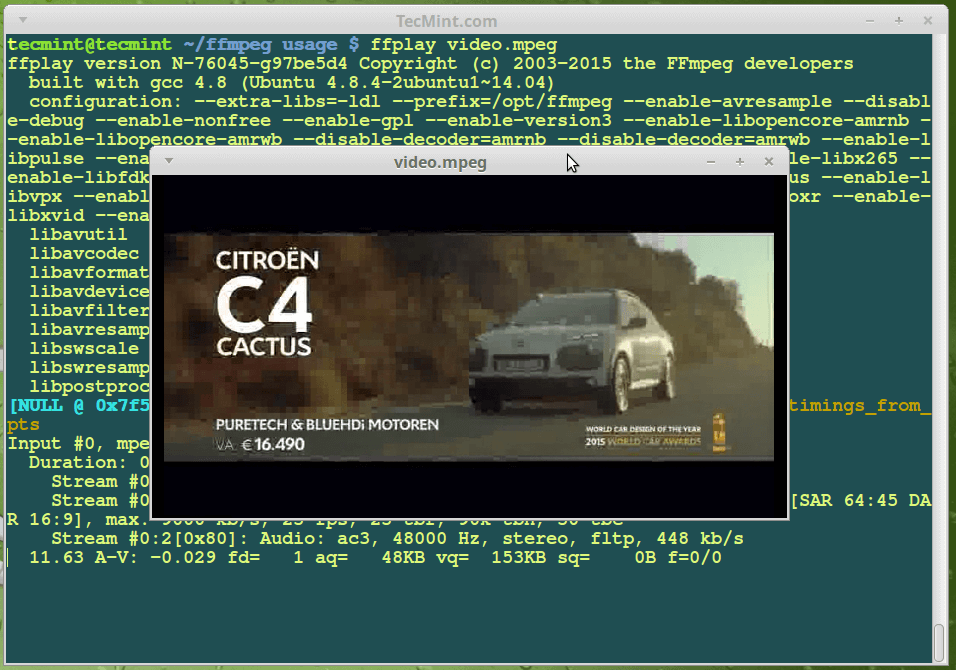
To test audio quality simply use the name of the audio file as follows:
$ ffplay audio_filename1.mp3
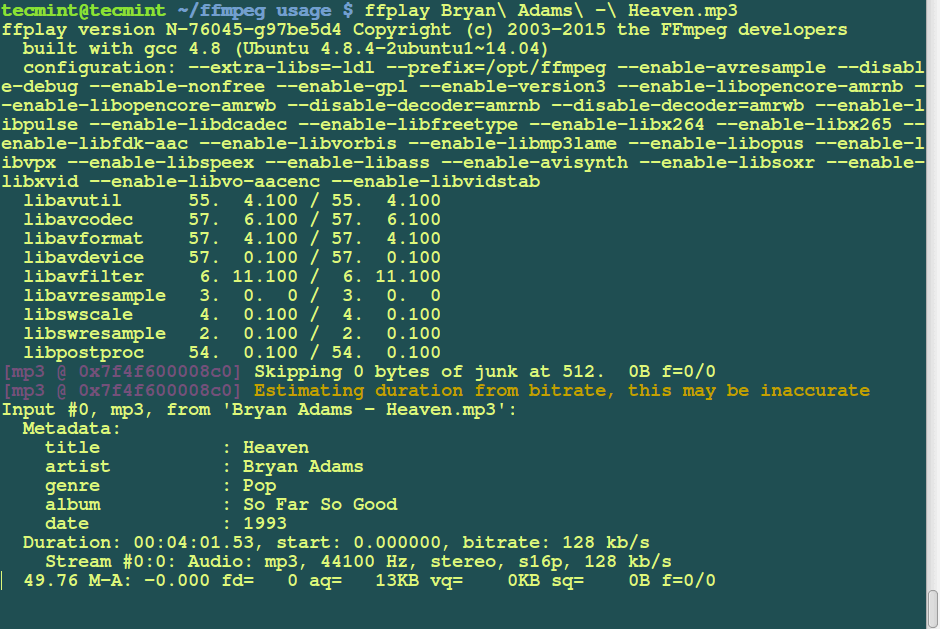
You can listen to them while they play and compare the qualities from the sound.
14. Add Photo or Banner to Audio
You can add a cover poster or image to an audio file using the following command, this comes very useful for uploading MP3s to YouTube.
$ ffmpeg -loop 1 -i image.jpg -i Bryan\ Adams\ -\ Heaven.mp3 -c:v libx264 -c:a aac -strict experimental -b:a 192k -shortest output.mp4
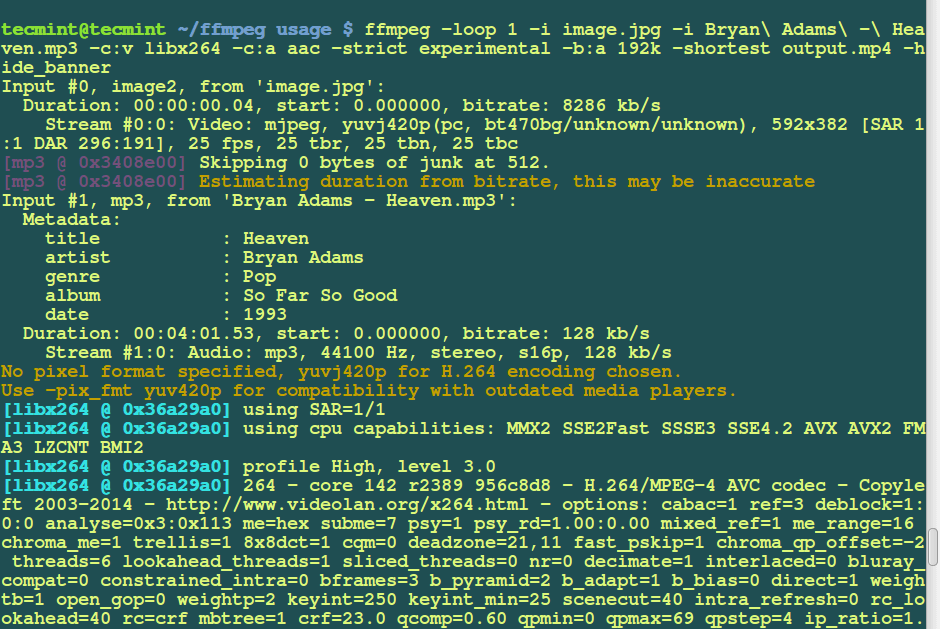
15. Add subtitles to a Movie
If you have a separate subtitle file called subtitle.srt, you can use following command to add subtitle to a movie file:
$ ffmpeg -i video.mp4 -i subtitles.srt -map 0 -map 1 -c copy -c:v libx264 -crf 23 -preset veryfast video-output.mkv
Summary
That is all for now but these are just few examples of using FFmpeg, you can find more options for what you wish to accomplish. Remember to post a comment to provide information about how to use FFmpeg or if you have encountered errors while using it.
Reference: https://ffmpeg.org/


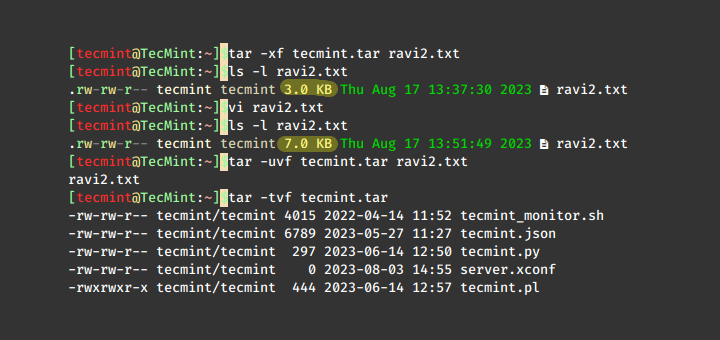
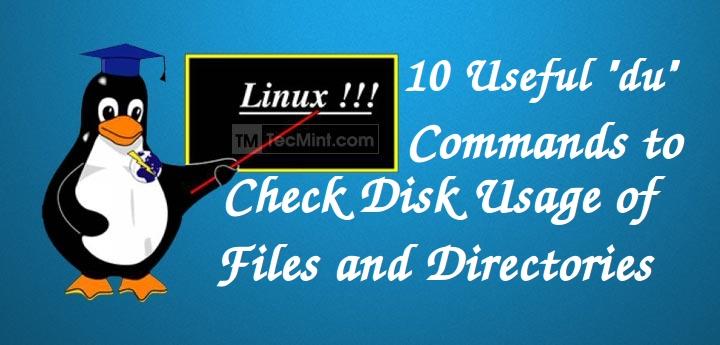
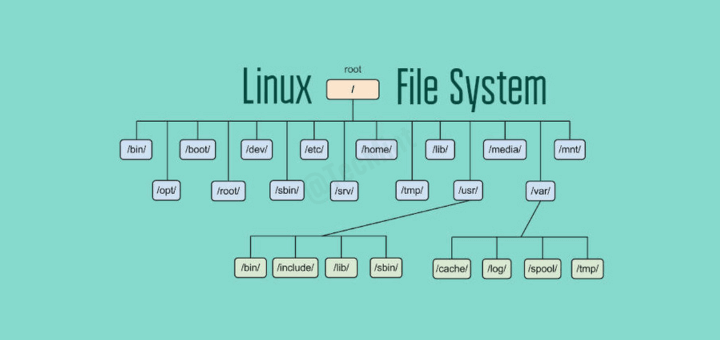

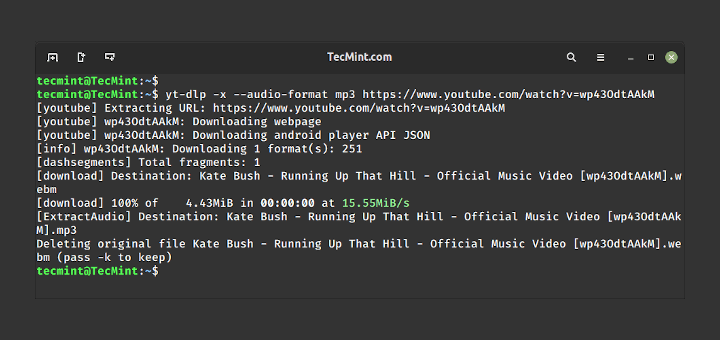
Hi tecMint,
Elsewhere
(https://larryjordan.com/articles/change-your-movies-poster-frame/)a solution was provided several years ago – Can I ask if you think this command (by PAJ) will work to change a movie files poster-image and hence finder icon on Big Sur in 2021ffmpeg : ffmpeg -i in.mp4 -I yourposterimage.jpg -map 0 -map 1 -c copy -c:v:1 mjpeg -disposition:v:1 attached_pic out.mp4Thanks
Hi, I do not know how to edit the comment. If the formula as a bat file also, I would be happy.
thank you
@jraju
Try to understand the command syntax, it is easy. Give it a try. You can start by running the same commands in the guide.
Hi, can you please tell the ffmpeg, ffprobe, or ffplay command to test all the files in a folder that has the same video codec and audio codec? For eg, if the video is x264 and audio mp3 is in a reference file I want all the files that differ from it has to be shown through the command. I do not want any other parameters.
can you supply the command?
In a number of the examples above, you have missed off the
"k"[kilo] for the -ab [bitrate] parameter.In your screen grabs, it even shows the warning message from ffmpeg stating that the bit rate is extremely low and did you forget to include the
"k".So in the examples it should be
"-ab 192k","-ab 320k"etc …@Erik
Thanks for mentioning this.
it is possible to reduce the image size but not the resolution ?
If possible how?
@Kamal
I guess it it possible, we will find a way to do that and let you know soon.